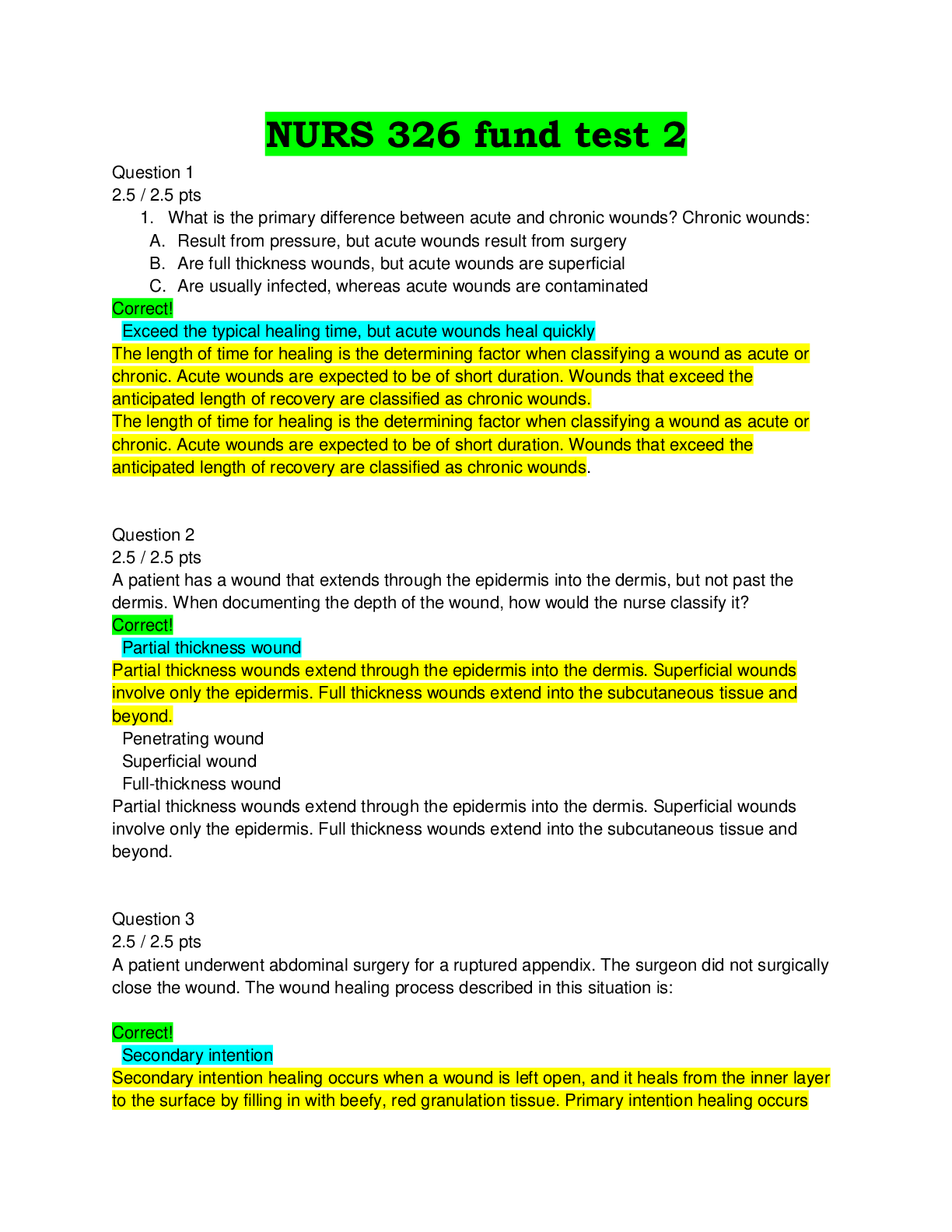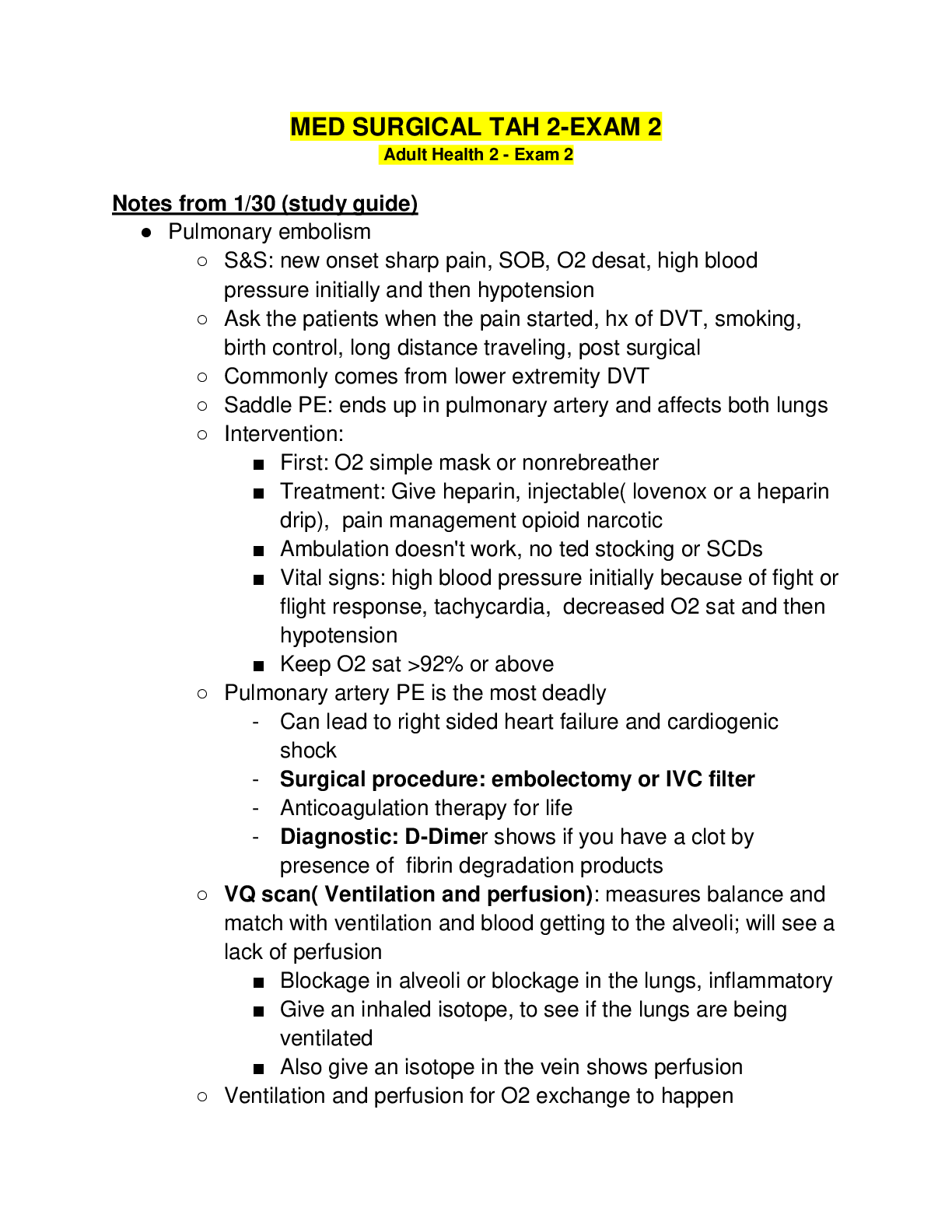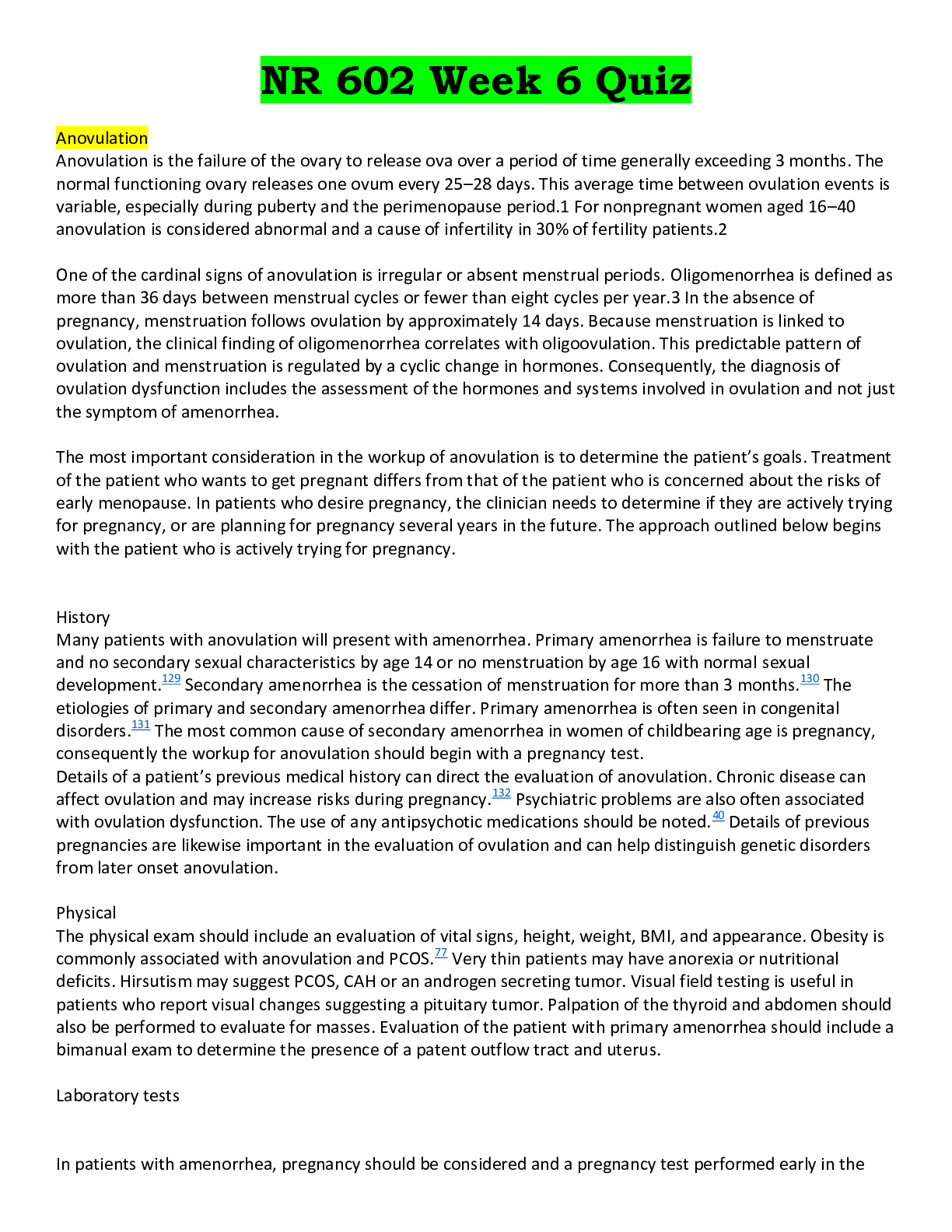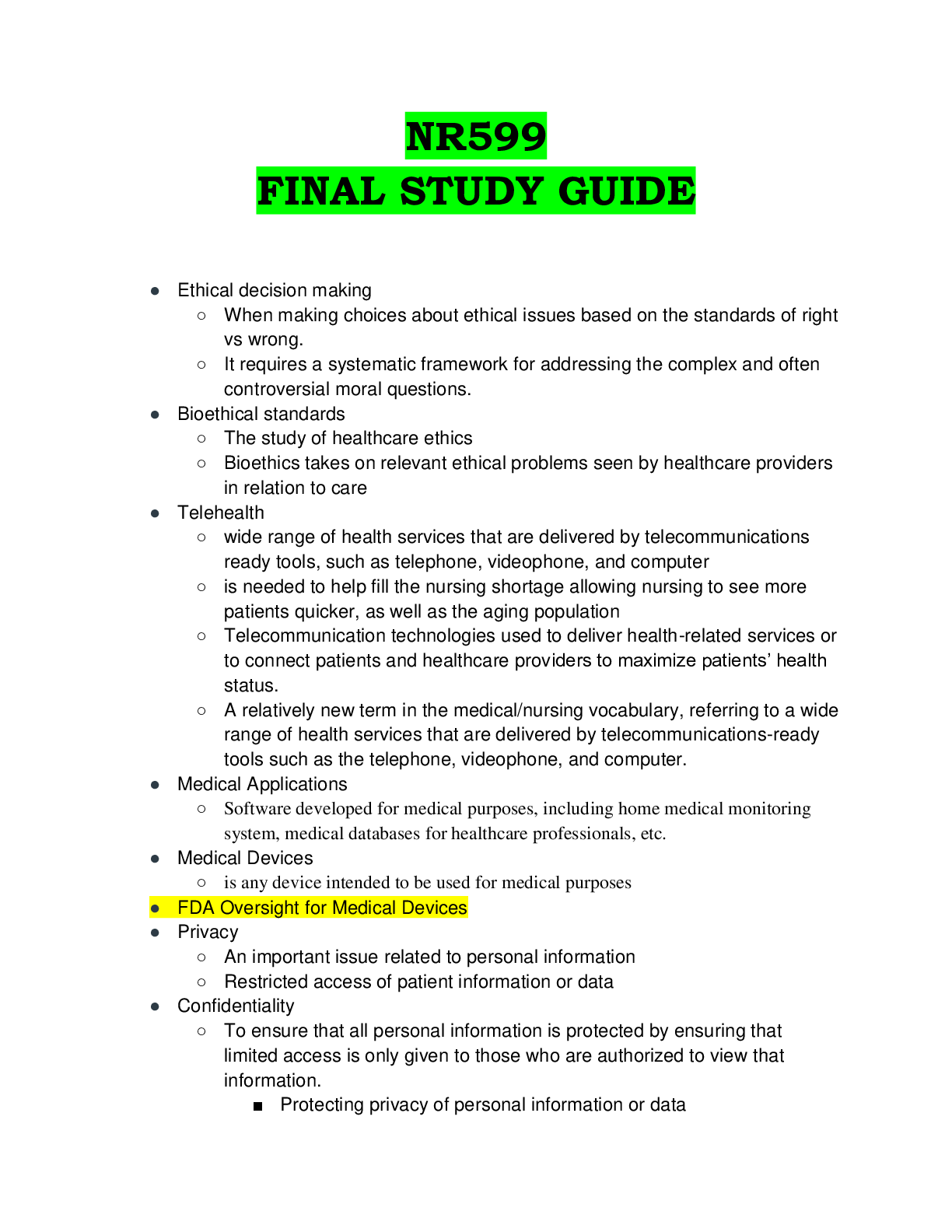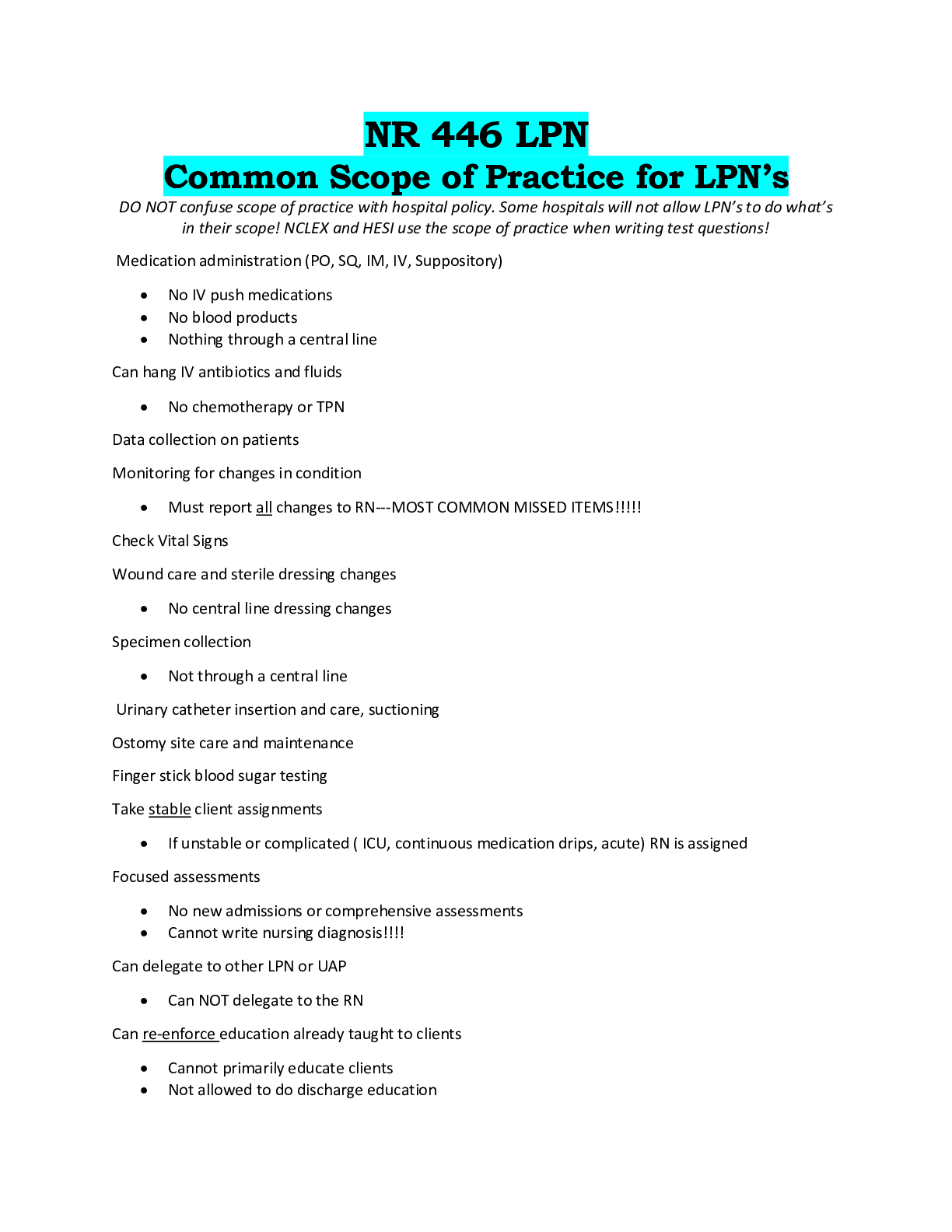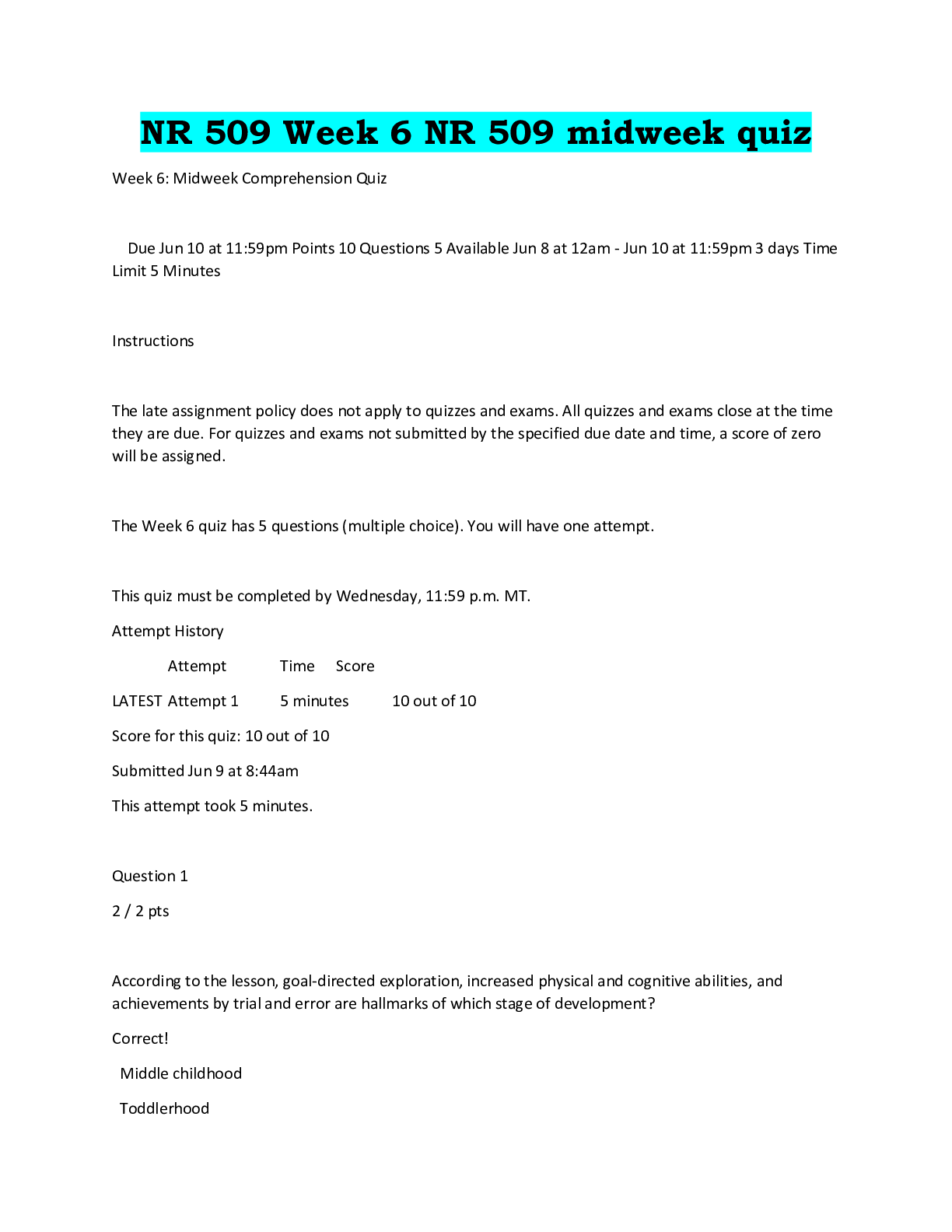*NURSING > EXAM REVIEW > NURSING ADULT 2 Prep Chapter 52 Answers (Correct) Provided (All)
NURSING ADULT 2 Prep Chapter 52 Answers (Correct) Provided
Document Content and Description Below
NURSING ADULT 2 Prep Chapter 52 Question 1 See full question 11s Report this Question A nurse is caring for a client who was recently diagnosed with hyperparathyroidism. Which statement by the cl... ient indicates the need for additional discharge teaching? You Selected: "I will increase my fluid and calcium intake." Correct response: "I will increase my fluid and calcium intake." Explanation: Reference: Hinkle, J.L., & Cheever, K.H., Brunner & Suddarth's Textbook of Medical-Surgical Nursing, 14th ed., Philadelphia, Wolters Kluwer, 2018, Chapter 52: Assessment and Management of Patients With Endocrine Disorders, Hyperparathyroidism, p. 1527. Chapter 52: Assessment and Management of Patients With Endocrine Disorders - Page 1527 Add a Note Question 2 See full question 11s Report this Question For a client with hyperthyroidism, treatment is most likely to include: You Selected: a thyroid hormone antagonist. Correct response: a thyroid hormone antagonist. Explanation: Reference: Hinkle, J.L., & Cheever, K.H., Brunner & Suddarth's Textbook of Medical-Surgical Nursing, 14th ed., Philadelphia, Wolters Kluwer, 2018, Chapter 52: Assessment and Management of Patients With Endocrine Disorders, Medical Management, p. 1519. Chapter 52: Assessment and Management of Patients With Endocrine Disorders - Page 1519 Add a Note Question 3 See full question 10s Report this Question A nurse is assessing a client with hyperthyroidism. What findings should the nurse expect? You Selected: Weight loss, nervousness, and tachycardia Correct response: Weight loss, nervousness, and tachycardia Explanation: Reference: Hinkle, J.L., & Cheever, K.H., Brunner & Suddarth's Textbook of Medical-Surgical Nursing, 14th ed., Philadelphia, Wolters Kluwer, 2018, Chapter 52: Assessment and Management of Patients With Endocrine Disorders, Clinical Manifestations, p. 1519. Chapter 52: Assessment and Management of Patients With Endocrine Disorders - Page 1519 Add a Note Question 4 See full question 9sReport this Question A client is scheduled for a diagnostic test to measure blood hormone levels. The nurse expects that this test will determine which of the following? You Selected: The functioning of endocrine glands Correct response: The functioning of endocrine glands Explanation: Reference: Hinkle, J.L., & Cheever, K.H., Brunner & Suddarth's Textbook of Medical-Surgical Nursing, 14th ed., Philadelphia, Wolters Kluwer, 2018, Chapter 52: Assessment and Management of Patients With Endocrine Disorders, Blood Tests, pp. 1505- 1506. Chapter 52: Assessment and Management of Patients With Endocrine Disorders - Page 1505-1506 Add a Note Question 5 See full question 10s Report this Question Which of the following would the nurse expect to find in a client with severe hyperthyroidism? You Selected: Exophthalmos Correct response: Exophthalmos Explanation: Reference: Hinkle, J.L., & Cheever, K.H., Brunner & Suddarth's Textbook of Medical-Surgical Nursing, 14th ed., Philadelphia, Wolters Kluwer, 2018, Chapter 52: Assessment and Management of Patients With Endocrine Disorders, Clinical Manifestations, p. 1519.Chapter 52: Assessment and Management of Patients With Endocrine Disorders - Page 1519 Add a Note Question 6 See full question 8s Report this Question While assessing a client with hypoparathyroidism, the nurse taps the client's facial nerve and observes twitching of the mouth and tightening of the jaw. The nurse would document this finding as which of the following? You Selected: Positive Chvostek's sign Correct response: Positive Chvostek's sign Explanation: Reference: Hinkle, J.L., & Cheever, K.H., Brunner & Suddarth's Textbook of Medical-Surgical Nursing, 14th ed., Philadelphia, Wolters Kluwer, 2018, Chapter 52: Assessment and Management of Patients With Endocrine Disorders, Assessment and Diagnostic Findings, p. 1530. Chapter 52: Assessment and Management of Patients With Endocrine Disorders - Page 1530 Add a Note Question 7 See full question 9s Report this Question The actions of parathyroid hormone (PTH) are increased in the presence of which vitamin? You Selected: D Correct response: D Explanation: Reference: Hinkle, J.L., & Cheever, K.H., Brunner & Suddarth's Textbook of Medical-Surgical Nursing, 14th ed., Philadelphia, Wolters Kluwer, 2018, Chapter 52: Assessment and Management of Patients With Endocrine Disorders, Anatomic and Physiologic Overview, p. 1527. Chapter 52: Assessment and Management of Patients With Endocrine Disorders - Page 1527 Add a Note Question 8 See full question 12s Report this Question A nursing student asks the instructor why the pituitary gland is called the “master gland.” What is the best response by the instructor? You Selected: “It regulates the function of other endocrine glands.” Correct response: “It regulates the function of other endocrine glands.” Explanation: Reference: Hinkle, J.L., & Cheever, K.H., Brunner & Suddarth's Textbook of Medical-Surgical Nursing, 14th ed., Philadelphia, Wolters Kluwer, 2018, Chapter 52: Assessment and Management of Patients With Endocrine Disorders, Anatomic and Physiologic Overview, p. 1506. Chapter 52: Assessment and Management of Patients With Endocrine Disorders - Page 1506 Add a Note Question 9 See full question 12sReport this Question A patient is suspected of having a pheochromocytoma and is having diagnostic tests done in the hospital. What symptoms does the nurse recognize as most significant for a patient with this disorder? You Selected: Blood pressure varying between 120/86 and 240/130 mm Hg Correct response: Blood pressure varying between 120/86 and 240/130 mm Hg Explanation: Reference: Hinkle, J.L., & Cheever, K.H., Brunner & Suddarth's Textbook of Medical-Surgical Nursing, 14th ed., Philadelphia, Wolters Kluwer, 2018, Chapter 52: Assessment and Management of Patients With Endocrine Disorders, Assessment and Diagnostic Findings, p. 1532. Chapter 52: Assessment and Management of Patients With Endocrine Disorders - Page 1532 Add a Note Question 10 See full question 1m 4s Report this Question A client has experienced several autoimmune disorders over the last 25 years, and lately has developed a new set of symptoms. What assessments would the nurse expect to find with a client with suspected Addison disease? Select all that apply. You Selected: Depression Increased appetite Hypoglycemia Correct response: Hypoglycemia Depression Hypotension Explanation:Question 1 See full question 14s Report this Question A client is returned to his room after a subtotal thyroidectomy. Which piece of equipment is most important for the nurse to keep at the client's bedside? You Selected: Tracheostomy set Correct response: Tracheostomy set Explanation: Reference: Hinkle, J.L., & Cheever, K.H., Brunner & Suddarth's Textbook of Medical-Surgical Nursing, 14th ed., Philadelphia, Wolters Kluwer, 2018, Chapter 52: Assessment and Management of Patients With Endocrine Disorders, Providing Postoperative Care, p. 1526. Chapter 52: Assessment and Management of Patients With Endocrine Disorders - Page 1526 Add a Note Question 2 See full question 18s Report this Question A middle-aged female client complains of anxiety, insomnia, weight loss, the inability to concentrate, and eyes feeling "gritty." Thyroid function tests reveal the following: thyroid-stimulating hormone (TSH) 0.02 U/ml, thyroxine 20 g/dl, and triiodothyronine 253 ng/dl. A 6-hour radioactive iodine uptake test showed a diffuse uptake of 85%. Based on these assessment findings, the nurse should suspect: You Selected: Graves' disease. Correct response: Graves' disease.Explanation: Reference: Hinkle, J.L., & Cheever, K.H., Brunner & Suddarth's Textbook of Medical-Surgical Nursing, 14th ed., Philadelphia, Wolters Kluwer, 2018, Chapter 52: Assessment and Management of Patients With Endocrine Disorders, Table 52-2, p. 1512. Chapter 52: Assessment and Management of Patients With Endocrine Disorders - Page 1512 Add a Note Question 3 See full question 7s Report this Question Which intervention is the most critical for a client with myxedema coma? You Selected: Maintaining a patent airway Correct response: Maintaining a patent airway Explanation: Reference: Hinkle, J.L., & Cheever, K.H., Brunner & Suddarth's Textbook of Medical-Surgical Nursing, 14th ed., Philadelphia, Wolters Kluwer, 2018, Chapter 52: Assessment and Management of Patients With Endocrine Disorders, Clinical Manifestations, pp. 1514-1515. Chapter 52: Assessment and Management of Patients With Endocrine Disorders - Page 1514-1515 Add a Note Question 4 See full question 25s Report this Question During the first 24 hours after a client is diagnosed with addisonian crisis, which intervention should the nurse perform frequently?You Selected: Assess vital signs. Correct response: Assess vital signs. Explanation: Reference: Hinkle, J.L., & Cheever, K.H., Brunner & Suddarth's Textbook of Medical-Surgical Nursing, 14th ed., Philadelphia, Wolters Kluwer, 2018, Chapter 52: Assessment and Management of Patients With Endocrine Disorders, Clinical Manifestations, p. 1534. Chapter 52: Assessment and Management of Patients With Endocrine Disorders - Page 1534 Add a Note Question 5 See full question 14s Report this Question Evaluation of an adult client reveals oversecretion of growth hormone. Which of the following would the nurse expect to find? You Selected: Bulging forehead Correct response: Bulging forehead Explanation: Reference: Hinkle, J.L., & Cheever, K.H., Brunner & Suddarth's Textbook of Medical-Surgical Nursing, 14th ed., Philadelphia, Wolters Kluwer, 2018, Chapter 52: Assessment and Management of Patients With Endocrine Disorders, Anterior Pituitary, p. 1508. Chapter 52: Assessment and Management of Patients With Endocrine Disorders - Page 1508 Add a NoteQuestion 6 See full question 24s Report this Question A client is receiving long-term treatment with high-dose corticosteroids. Which of the following would the nurse expect the client to exhibit? You Selected: Moon face Correct response: Moon face Explanation: Reference: Hinkle, J.L., & Cheever, K.H., Brunner & Suddarth's Textbook of Medical-Surgical Nursing, 14th ed., Philadelphia, Wolters Kluwer, 2018, Chapter 52: Assessment and Management of Patients With Endocrine Disorders, Table 52-5, p. 1542. Chapter 52: Assessment and Management of Patients With Endocrine Disorders - Page 1542 Add a Note Question 7 See full question 9s Report this Question Trousseau’s sign is elicited by which of the following? You Selected: Carpopedal spasm is induced by occluding the blood flow to the arm for 3 minutes with the use of a blood pressure cuff. Correct response: Carpopedal spasm is induced by occluding the blood flow to the arm for 3 minutes with the use of a blood pressure cuff. Explanation: Reference: Hinkle, J.L., & Cheever, K.H., Brunner & Suddarth's Textbook of Medical-Surgical Nursing, 14th ed., Philadelphia, Wolters Kluwer, 2018, Chapter 52: Assessment and Management of Patients With Endocrine Disorders, Assessment and Diagnostic Findings, p. 1530. Chapter 52: Assessment and Management of Patients With Endocrine Disorders - Page 1530 Add a Note Question 8 See full question 45s Report this Question The primary function of the thyroid gland includes which of the following? You Selected: Control of cellular metabolic activity Correct response: Control of cellular metabolic activity Explanation: Reference: Hinkle, J.L., & Cheever, K.H., Brunner & Suddarth's Textbook of Medical-Surgical Nursing, 14th ed., Philadelphia, Wolters Kluwer, 2018, Chapter 52: Assessment and Management of Patients With Endocrine Disorders, Function of Thyroid Hormone, p. 1511. Chapter 52: Assessment and Management of Patients With Endocrine Disorders - Page 1511 Add a Note Question 9 See full question 20s Report this Question Which are correct statements about the relationship between the hypothalamus and the pituitary gland? Select all that apply. You Selected: The pituitary gland is called the master gland because it regulates the function of the hypothalamus and other endocrine glands. Correct response: Many endocrine glands respond to stimulation from the pituitary gland, which is connected by a stalk to the hypothalamus in the brain. Under the influence of the hypothalamus, the lobes of the pituitary gland secrete various hormones. Explanation: Reference: Hinkle, J.L., & Cheever, K.H., Brunner & Suddarth's Textbook of Medical-Surgical Nursing, 14th ed., Philadelphia, Wolters Kluwer, 2018, Chapter 52: Assessment and Management of Patients With Endocrine Disorders, p. 1506. Chapter 52: Assessment and Management of Patients With Endocrine Disorders - Page 1506 Add a Note Question 10 See full question 12s Report this Question The nurse is reviewing a client’s history which reveals that the client has had an over secretion of growth hormone (GH) that occurred before puberty. The nurse interprets this as which of the following? You Selected: Gigantism Correct response: Gigantism Explanation: Question 1 See full question 22s Report this QuestionA nurse is assessing a client with Cushing's syndrome. Which observation should the nurse report to the physician immediately? You Selected: An irregular apical pulse Correct response: An irregular apical pulse Explanation: Reference: Hinkle, J.L., & Cheever, K.H., Brunner & Suddarth's Textbook of Medical-Surgical Nursing, 14th ed., Philadelphia, Wolters Kluwer, 2018, Chapter 52: Assessment and Management of Patients With Endocrine Disorders, Monitoring and Managing Potential Complications, p. 1539. Chapter 52: Assessment and Management of Patients With Endocrine Disorders - Page 1539 Add a Note Question 2 See full question 10s Report this Question A nurse explains to a client with thyroid disease that the thyroid gland normally produces: You Selected: T3, thyroxine (T4), and calcitonin. Correct response: T3, thyroxine (T4), and calcitonin. Explanation: Reference: Hinkle, J.L., & Cheever, K.H., Brunner & Suddarth's Textbook of Medical-Surgical Nursing, 14th ed., Philadelphia, Wolters Kluwer, 2018, Chapter 52: Assessment and Management of Patients With Endocrine Disorders, The Thyroid Gland, p. 1510. Chapter 52: Assessment and Management of Patients With Endocrine Disorders - Page 1510Add a Note Question 3 See full question 10s Report this Question Antithyroid medications are not generally recommended for elderly patients because of which side effect? You Selected: Granulocytopenia Correct response: Granulocytopenia Explanation: Reference: Hinkle, J.L., & Cheever, K.H., Brunner & Suddarth's Textbook of Medical-Surgical Nursing, 14th ed., Philadelphia, Wolters Kluwer, 2018, Chapter 52: Assessment and Management of Patients With Endocrine Disorders, p. 1521. Chapter 52: Assessment and Management of Patients With Endocrine Disorders - Page 1521 Add a Note Question 4 See full question 8s Report this Question Which assessment would a nurse perform on a client with Cushing’s syndrome who is at high risk of developing a peptic ulcer? You Selected: Observe stool color. Correct response: Observe stool color. Explanation:Reference: Hinkle, J.L., & Cheever, K.H., Brunner & Suddarth's Textbook of Medical-Surgical Nursing, 14th ed., Philadelphia, Wolters Kluwer, 2018, Chapter 52: Assessment and Management of Patients With Endocrine Disorders, Preparing the Patient for Surgery, p. 1538. Chapter 52: Assessment and Management of Patients With Endocrine Disorders - Page 1538 Add a Note Question 5 See full question 1m 49s Report this Question A client with acromegaly is admitted to the hospital with complaints of partial blindness that began suddenly. What does the nurse suspect is occurring with this client? You Selected: Retinal detachment Correct response: Pressure on the optic nerve Explanation: Reference: Hinkle, J.L., & Cheever, K.H., Brunner & Suddarth's Textbook of Medical-Surgical Nursing, 14th ed., Philadelphia, Wolters Kluwer, 2018, Chapter 52: Assessment and Management of Patients With Endocrine Disorders, Clinical Manifestations, p. 1508. Chapter 52: Assessment and Management of Patients With Endocrine Disorders - Page 1508 Add a Note Question 6 See full question 15s Report this Question A client has a decreased level of thyroid hormone being excreted. What will the feedback loop do to maintain the level of thyroid hormone required to maintain homeostatic stability? You Selected: Stimulate more hormones using the negative feedback system Correct response: Stimulate more hormones using the negative feedback system Explanation: Reference: Hinkle, J.L., & Cheever, K.H., Brunner & Suddarth's Textbook of Medical-Surgical Nursing, 14th ed., Philadelphia, Wolters Kluwer, 2018, Chapter 52: Assessment and Management of Patients With Endocrine Disorders, Regulation of Thyroid Hormone, p. 1511. Chapter 52: Assessment and Management of Patients With Endocrine Disorders - Page 1511 Add a Note Question 7 See full question 9s Report this Question A client is suspected to have a pituitary tumor due to signs of diabetes insipidus. What initial test does the nurse help to prepare the client for? You Selected: Magnetic resonance imaging (MRI) Correct response: Magnetic resonance imaging (MRI) Explanation: Reference: Hinkle, J.L., & Cheever, K.H., Brunner & Suddarth's Textbook of Medical-Surgical Nursing, 14th ed., Philadelphia, Wolters Kluwer, 2018, Chapter 52: Assessment and Management of Patients With Endocrine Disorders, Assessment and Diagnostic Findings, p. 1509. Chapter 52: Assessment and Management of Patients With Endocrine Disorders - Page 1509 Add a Note Question 8 See full question8s Report this Question Which disorder is characterized by a group of symptoms produced by an excess of free circulating cortisol from the adrenal cortex? You Selected: Cushing syndrome Correct response: Cushing syndrome Explanation: Reference: Hinkle, J.L., & Cheever, K.H., Brunner & Suddarth's Textbook of Medical-Surgical Nursing, 14th ed., Philadelphia, Wolters Kluwer, 2018, Chapter 52: Assessment and Management of Patients With Endocrine Disorders, Cushing Syndrome, p. 1536. Chapter 52: Assessment and Management of Patients With Endocrine Disorders - Page 1536 Add a Note Question 9 See full question 8s Report this Question The nurse assesses a patient who has an obvious goiter. What type of deficiency does the nurse recognize is most likely the cause of this? You Selected: Iodine Correct response: Iodine Explanation: Reference: Hinkle, J.L., & Cheever, K.H., Brunner & Suddarth's Textbook of Medical-Surgical Nursing, 14th ed., Philadelphia, Wolters Kluwer, 2018, Chapter 52: Assessment and Management of Patients With Endocrine Disorders, Pathophysiology, p. 1511.Chapter 52: Assessment and Management of Patients With Endocrine Disorders - Page 1511 Add a Note Question 10 See full question 10s Report this Question A nurse is assigned to care for a patient with increased parathormone secretion. Which of the following serum levels should the nurse monitor for this patient? You Selected: Calcium Correct response: Calcium Explanation: n 1 See full question 13s Report this Question A client is admitted for treatment of the syndrome of inappropriate antidiuretic hormone (SIADH). Which nursing intervention is appropriate? You Selected: Restricting fluids Correct response: Restricting fluids Explanation: Reference: Hinkle, J.L., & Cheever, K.H., Brunner & Suddarth's Textbook of Medical-Surgical Nursing, 14th ed., Philadelphia, Wolters Kluwer, 2018, Chapter 52: Assessment and Management of Patients With Endocrine Disorders, Syndrome of Inappropriate Antidiuretic Hormone Secretion, p. 1510.Chapter 52: Assessment and Management of Patients With Endocrine Disorders - Page 1510 Add a Note Question 2 See full question 10s Report this Question A client receiving thyroid replacement therapy develops influenza and forgets to take her thyroid replacement medicine. The nurse understands that skipping this medication puts the client at risk for developing which life-threatening complication? You Selected: Myxedema coma Correct response: Myxedema coma Explanation: Reference: Hinkle, J.L., & Cheever, K.H., Brunner & Suddarth's Textbook of Medical-Surgical Nursing, 14th ed., Philadelphia, Wolters Kluwer, 2018, Chapter 52: Assessment and Management of Patients With Endocrine Disorders, Clinical Manifestations, p. 1515. Chapter 52: Assessment and Management of Patients With Endocrine Disorders - Page 1515 Add a Note Question 3 See full question 12s Report this Question Which condition should a nurse expect to find in a client diagnosed with hyperparathyroidism? You Selected: Hyperphosphatemia Correct response: Hypercalcemia Explanation: Reference: Hinkle, J.L., & Cheever, K.H., Brunner & Suddarth's Textbook of Medical-Surgical Nursing, 14th ed., Philadelphia, Wolters Kluwer, 2018, Chapter 52: Assessment and Management of Patients With Endocrine Disorders, Assessment and Diagnostic Findings, p. 1528. Chapter 52: Assessment and Management of Patients With Endocrine Disorders - Page 1528 Add a Note Question 4 See full question 11s Report this Question A client with acromegaly has been given the option of a surgical approach or a medical approach. The client decides to have a surgical procedure to remove the pituitary gland. What does the nurse understand this surgical procedure is called? You Selected: Hypophysectomy Correct response: Hypophysectomy Explanation: Reference: Hinkle, J.L., & Cheever, K.H., Brunner & Suddarth's Textbook of Medical-Surgical Nursing, 14th ed., Philadelphia, Wolters Kluwer, 2018, Chapter 52: Assessment and Management of Patients With Endocrine Disorders, Glossary, p. 1502. Chapter 52: Assessment and Management of Patients With Endocrine Disorders - Page 1502 Add a Note Question 5 See full question 59sReport this Question A client sustained a head injury when falling off of a ladder. While in the hospital, the client begins voiding large amounts of clear urine and states he is very thirsty. The client states that he feels weak, and he has had an 8-lb weight loss since admission. What should the client be tested for? You Selected: Hypothyroidism Correct response: Diabetes insipidus (DI) Explanation: Reference: Hinkle, J.L., & Cheever, K.H., Brunner & Suddarth's Textbook of Medical-Surgical Nursing, 14th ed., Philadelphia, Wolters Kluwer, 2018, Chapter 52: Assessment and Management of Patients With Endocrine Disorders, Diabetes Insipidus, p. 1509. Chapter 52: Assessment and Management of Patients With Endocrine Disorders - Page 1509 Add a Note Question 6 See full question 12s Report this Question What interventions can the nurse encourage the client with diabetes insipidus to do in order to control thirst and compensate for urine loss? You Selected: Consume adequate amounts of fluid. Correct response: Consume adequate amounts of fluid. Explanation: Reference: Hinkle, J.L., & Cheever, K.H., Brunner & Suddarth's Textbook of Medical-Surgical Nursing, 14th ed., Philadelphia, Wolters Kluwer, 2018, Chapter 52: Assessmentand Management of Patients With Endocrine Disorders, Medical Management, p. 1509. Chapter 52: Assessment and Management of Patients With Endocrine Disorders - Page 1509 Add a Note Question 7 See full question 13s Report this Question A client has a dysfunction in one of his glands that is causing a decrease in the level of calcium in the blood. What gland should be evaluated for dysfunction? You Selected: Thyroid gland Correct response: Parathyroid gland Explanation: Reference: Hinkle, J.L., & Cheever, K.H., Brunner & Suddarth's Textbook of Medical-Surgical Nursing, 14th ed., Philadelphia, Wolters Kluwer, 2018, Chapter 52: Assessment and Management of Patients With Endocrine Disorders, Table 52-1: Major Action and Source of Selected Hormones, p. 1505. Chapter 52: Assessment and Management of Patients With Endocrine Disorders - Page 1505 Add a Note Question 8 See full question 1m 4s Report this Question The nurse is caring for a patient with hyperparathyroidism and observes a calcium level of 16.2 mg/dL. What interventions does the nurse prepare to provide to reduce the calcium level? Select all that apply. You Selected: Administration of calcitonin Monitoring the patient for fluid overload Intravenous isotonic saline solution in large quantities Correct response: Administration of calcitonin Intravenous isotonic saline solution in large quantities Monitoring the patient for fluid overload Explanation: Reference: Hinkle, J.L., & Cheever, K.H., Brunner & Suddarth's Textbook of Medical-Surgical Nursing, 14th ed., Philadelphia, Wolters Kluwer, 2018, Chapter 52: Assessment and Management of Patients With Endocrine Disorders, Medical Management, p. 1528. Chapter 52: Assessment and Management of Patients With Endocrine Disorders - Page 1528 Add a Note Question 9 See full question 20s Report this Question A patient is ordered desmopressin (DDAVP) for the treatment of diabetes insipidus. What therapeutic response does the nurse anticipate the patient will experience? You Selected: A decrease in urine output Correct response: A decrease in urine output Explanation: Reference: Hinkle, J.L., & Cheever, K.H., Brunner & Suddarth's Textbook of Medical-Surgical Nursing, 14th ed., Philadelphia, Wolters Kluwer, 2018, Chapter 52: Assessment and Management of Patients With Endocrine Disorders, Pharmacologic Therapy, p. 1510.Chapter 52: Assessment and Management of Patients With Endocrine Disorders - Page 1510 Add a Note Question 10 See full question 9s Report this Question The nurse assesses a patient who has been diagnosed with Addison's disease. Which of the following is a diagnostic sign of this disease? You Selected: Potassium of 6.0 mEq/L Correct response: Potassium of 6.0 mEq/L Explanation: Question 1 See full question 26s Report this Question A client is admitted to the health care facility for evaluation for Addison's disease. Which laboratory test result best supports a diagnosis of Addison's disease? You Selected: Serum potassium level of 5.8 mEq/L Correct response: Serum potassium level of 5.8 mEq/L Explanation: Reference: Hinkle, J.L., & Cheever, K.H., Brunner & Suddarth's Textbook of Medical-Surgical Nursing, 14th ed., Philadelphia, Wolters Kluwer, 2018, Chapter 52: Assessment and Management of Patients With Endocrine Disorders, Clinical Manifestations, p. 1534.Chapter 52: Assessment and Management of Patients With Endocrine Disorders - Page 1534 Add a Note Question 2 See full question 27s Report this Question Which nursing diagnosis takes highest priority for a client with hyperthyroidism? You Selected: Risk for imbalanced nutrition: More than body requirements related to thyroid hormone excess Correct response: Imbalanced nutrition: Less than body requirements related to thyroid hormone excess Explanation: Reference: Hinkle, J.L., & Cheever, K.H., Brunner & Suddarth's Textbook of Medical-Surgical Nursing, 14th ed., Philadelphia, Wolters Kluwer, 2018, Chapter 52: Assessment and Management of Patients With Endocrine Disorders, Nursing Interventions, p. 1523. Chapter 52: Assessment and Management of Patients With Endocrine Disorders - Page 1523 Add a Note Question 3 See full question 10s Report this Question Which outcome indicates that treatment of a client with diabetes insipidus has been effective? You Selected: Fluid intake is less than 2,500 ml/day. Correct response: Fluid intake is less than 2,500 ml/day. Explanation: Reference: Hinkle, J.L., & Cheever, K.H., Brunner & Suddarth's Textbook of Medical-Surgical Nursing, 14th ed., Philadelphia, Wolters Kluwer, 2018, Chapter 52: Assessment and Management of Patients With Endocrine Disorders, Medical Management, pp. 1509-1510. Chapter 52: Assessment and Management of Patients With Endocrine Disorders - Page 1509-1510 Add a Note Question 4 See full question 11s Report this Question Dilutional hyponatremia occurs in which disorder? You Selected: Syndrome of inappropriate antidiuretic hormone secretion (SIADH) Correct response: Syndrome of inappropriate antidiuretic hormone secretion (SIADH) Explanation: Reference: Hinkle, J.L., & Cheever, K.H., Brunner & Suddarth's Textbook of Medical-Surgical Nursing, 14th ed., Philadelphia, Wolters Kluwer, 2018, Chapter 52: Assessment and Management of Patients With Endocrine Disorders, Syndrome of Inappropriate Antidiuretic Hormone Secretion, p. 1510. Chapter 52: Assessment and Management of Patients With Endocrine Disorders - Page 1510 Add a Note Question 5 See full question 8s Report this QuestionA client has been experiencing a decrease in serum calcium. After diagnostics, the physician proposes the calcium level fluctuation is due to altered parathyroid function. What is the typical number of parathyroid glands? You Selected: four Correct response: four Explanation: Reference: Hinkle, J.L., & Cheever, K.H., Brunner & Suddarth's Textbook of Medical-Surgical Nursing, 14th ed., Philadelphia, Wolters Kluwer, 2018, Chapter 52: Assessment and Management of Patients With Endocrine Disorders, Anatomic and Physiologic Overview, p. 1527. Chapter 52: Assessment and Management of Patients With Endocrine Disorders - Page 1527 Add a Note Question 6 See full question 25s Report this Question A client has been diagnosed with myxedema from long-standing hypothyroidism. What clinical manifestations of this disorder does the nurse recognize are progressing to myxedema coma? Select all that apply. You Selected: Hypoventilation Hypothermia Hypotension Correct response: Hypothermia Hypotension Hypoventilation Explanation: Reference: Hinkle, J.L., & Cheever, K.H., Brunner & Suddarth's Textbook of Medical-Surgical Nursing, 14th ed., Philadelphia, Wolters Kluwer, 2018, Chapter 52: Assessment and Management of Patients With Endocrine Disorders, Clinical Manifestations, p. 1514. Chapter 52: Assessment and Management of Patients With Endocrine Disorders - Page 1514 Add a Note Question 7 See full question 10s Report this Question After a thyroidectomy, the client develops a carpopedal spasm while the nurse is taking a BP reading on the left arm. Which action by the nurse is appropriate? You Selected: Administer IV calcium gluconate as ordered. Correct response: Administer IV calcium gluconate as ordered. Explanation: Reference: Hinkle, J.L., & Cheever, K.H., Brunner & Suddarth's Textbook of Medical-Surgical Nursing, 14th ed., Philadelphia, Wolters Kluwer, 2018, Chapter 52: Assessment and Management of Patients With Endocrine Disorders, Nursing Management, p. 1530. Chapter 52: Assessment and Management of Patients With Endocrine Disorders - Page 1530 Add a Note Question 8 See full question 57s Report this Question A nurse is aware that several laboratory results are present in a patient diagnosed with diabetes insipidus. Select all that apply. You Selected: Urine specific gravity of 1.001 Serum sodium level of 149 mEq/L Serum osmolality of 310 mOsm/kg Correct response: Urine specific gravity of 1.001 Serum osmolality of 310 mOsm/kg Serum sodium level of 149 mEq/L Explanation: Reference: Hinkle, J.L., & Cheever, K.H., Brunner & Suddarth's Textbook of Medical-Surgical Nursing, 14th ed., Philadelphia, Wolters Kluwer, 2018, Chapter 52: Assessment and Management of Patients With Endocrine Disorders, Clinical Manifestations, p. 1509. Chapter 52: Assessment and Management of Patients With Endocrine Disorders - Page 1509 Add a Note Question 9 See full question 49s Report this Question Surgical removal of the thyroid gland is the treatment of choice for thyroid cancer. During the immediate postoperative period, the nurse knows to evaluate serum levels of __________ to assess for a serious and primary postoperative complication of thyroidectomy. You Selected: Potassium Correct response: Calcium Explanation: Reference: Hinkle, J.L., & Cheever, K.H., Brunner & Suddarth's Textbook of Medical-Surgical Nursing, 14th ed., Philadelphia, Wolters Kluwer, 2018, Chapter 52: Assessment and Management of Patients With Endocrine Disorders, Medical Management, p. 1526.Chapter 52: Assessment and Management of Patients With Endocrine Disorders - Page 1526 Add a Note Question 10 See full question 47s Report this Question Antithyroid medications are contraindicated in late pregnancy due to the fact that which of the following may occur? Select all that apply. You Selected: Fetal hypothyroidism Cretinism Fetal bradycardia Goiter Correct response: Fetal hypothyroidism Fetal bradycardia Goiter Cretinism Question 1 See full question 16s Report this Question A client with Addison's disease comes to the clinic for a follow-up visit. When assessing this client, the nurse should stay alert for signs and symptoms of: You Selected: calcium and phosphorus abnormalities. Correct response: sodium and potassium abnormalities. Explanation: Reference: Hinkle, J.L., & Cheever, K.H., Brunner & Suddarth's Textbook of Medical-Surgical Nursing, 14th ed., Philadelphia, Wolters Kluwer, 2018, Chapter 52: Assessment and Management of Patients With Endocrine Disorders, Clinical Manifestations, p. 1534. Chapter 52: Assessment and Management of Patients With Endocrine Disorders - Page 1534 Add a Note Question 2 See full question 15s Report this Question A middle-aged female client complains of anxiety, insomnia, weight loss, the inability to concentrate, and eyes feeling "gritty." Thyroid function tests reveal the following: thyroid-stimulating hormone (TSH) 0.02 U/ml, thyroxine 20 g/dl, and triiodothyronine 253 ng/dl. A 6-hour radioactive iodine uptake test showed a diffuse uptake of 85%. Based on these assessment findings, the nurse should suspect: You Selected: Graves' disease. Correct response: Graves' disease. Explanation: Reference: Hinkle, J.L., & Cheever, K.H., Brunner & Suddarth's Textbook of Medical-Surgical Nursing, 14th ed., Philadelphia, Wolters Kluwer, 2018, Chapter 52: Assessment and Management of Patients With Endocrine Disorders, Table 52-2, p. 1512. Chapter 52: Assessment and Management of Patients With Endocrine Disorders - Page 1512 Add a Note Question 3 See full question 10s Report this Question What is the most common cause of hyperaldosteronism?You Selected: An adrenal adenoma Correct response: An adrenal adenoma Explanation: Reference: Hinkle, J.L., & Cheever, K.H., Brunner & Suddarth's Textbook of Medical-Surgical Nursing, 14th ed., Philadelphia, Wolters Kluwer, 2018. Add a Note Question 4 See full question 18s Report this Question A client with hypothyroidism is afraid of needles and doesn't want to have his blood drawn. What should the nurse say to help alleviate his concerns? You Selected: "I'll stay here with you while the technician draws your blood." Correct response: "I'll stay here with you while the technician draws your blood." Explanation: Reference: Hinkle, J.L., & Cheever, K.H., Brunner & Suddarth's Textbook of Medical-Surgical Nursing, 14th ed., Philadelphia, Wolters Kluwer, 2018, Chapter 52: Assessment and Management of Patients With Endocrine Disorders, Medical Management, p. 1515. Chapter 52: Assessment and Management of Patients With Endocrine Disorders - Page 1515 Add a Note Question 5 See full question 1m 15sReport this Question Which assessment is done by the nurse when conducting a physical examination? You Selected: Palpate the thyroid gland repeatedly Correct response: Examine the shape and color of the nails Explanation: Reference: Hinkle, J.L., & Cheever, K.H., Brunner & Suddarth's Textbook of Medical-Surgical Nursing, 14th ed., Philadelphia, Wolters Kluwer, 2018, Chapter 52: Assessment and Management of Patients With Endocrine Disorders, p. 1514. Chapter 52: Assessment and Management of Patients With Endocrine Disorders - Page 1514 Add a Note Question 6 See full question 9s Report this Question Beta-blockers are used in the treatment of hyperthyroidism to counteract which of the following effects? You Selected: Sympathetic Correct response: Sympathetic Explanation: Reference: Hinkle, J.L., & Cheever, K.H., Brunner & Suddarth's Textbook of Medical-Surgical Nursing, 14th ed., Philadelphia, Wolters Kluwer, 2018, Chapter 52: Assessment and Management of Patients With Endocrine Disorders, Monitoring and Managing Potential Complications, p. 1523.Chapter 52: Assessment and Management of Patients With Endocrine Disorders - Page 1523 Add a Note Question 7 See full question 11s Report this Question During physical examination of a client with a suspected endocrine disorder, the nurse assesses the body structures. The nurse gathers this data based on the understanding that it is an important aid in which of the following? You Selected: Detecting evidence of hormone hypersecretion Correct response: Detecting evidence of hormone hypersecretion Explanation: Reference: Hinkle, J.L., & Cheever, K.H., Brunner & Suddarth's Textbook of Medical-Surgical Nursing, 14th ed., Philadelphia, Wolters Kluwer, 2018. Add a Note Question 8 See full question 10s Report this Question A patient taking corticosteroids for exacerbation of Crohn’s disease comes to the clinic and informs the nurse that he wants to stop taking them because of the increase in acne and moon face. What can the nurse educate the patient regarding these symptoms? You Selected: The moon face and acne will resolve when the medication is tapered off. Correct response: The moon face and acne will resolve when the medication is tapered off.Explanation: Reference: Hinkle, J.L., & Cheever, K.H., Brunner & Suddarth's Textbook of Medical-Surgical Nursing, 14th ed., Philadelphia, Wolters Kluwer, 2018, Chapter 52: Assessment and Management of Patients With Endocrine Disorders, Table 52-5, p. 1542. Chapter 52: Assessment and Management of Patients With Endocrine Disorders - Page 1542 Add a Note Question 9 See full question 8s Report this Question Patients with hyperthyroidism are characteristically: You Selected: Sensitive to heat Correct response: Sensitive to heat Explanation: Reference: Hinkle, J.L., & Cheever, K.H., Brunner & Suddarth's Textbook of Medical-Surgical Nursing, 14th ed., Philadelphia, Wolters Kluwer, 2018, Chapter 52: Assessment and Management of Patients With Endocrine Disorders, Clinical Manifestations, p. 1519. Chapter 52: Assessment and Management of Patients With Endocrine Disorders - Page 1519 Add a Note Question 10 See full question 11s Report this Question A patient experiences a life-threatening hypercalcemic crisis. The provider orders a cytotoxic agent. Which of the following is most likely the drug that is prescribed?You Selected: Mithramycin Correct response: Mithramycin [Show More]
Last updated: 1 year ago
Preview 1 out of 36 pages
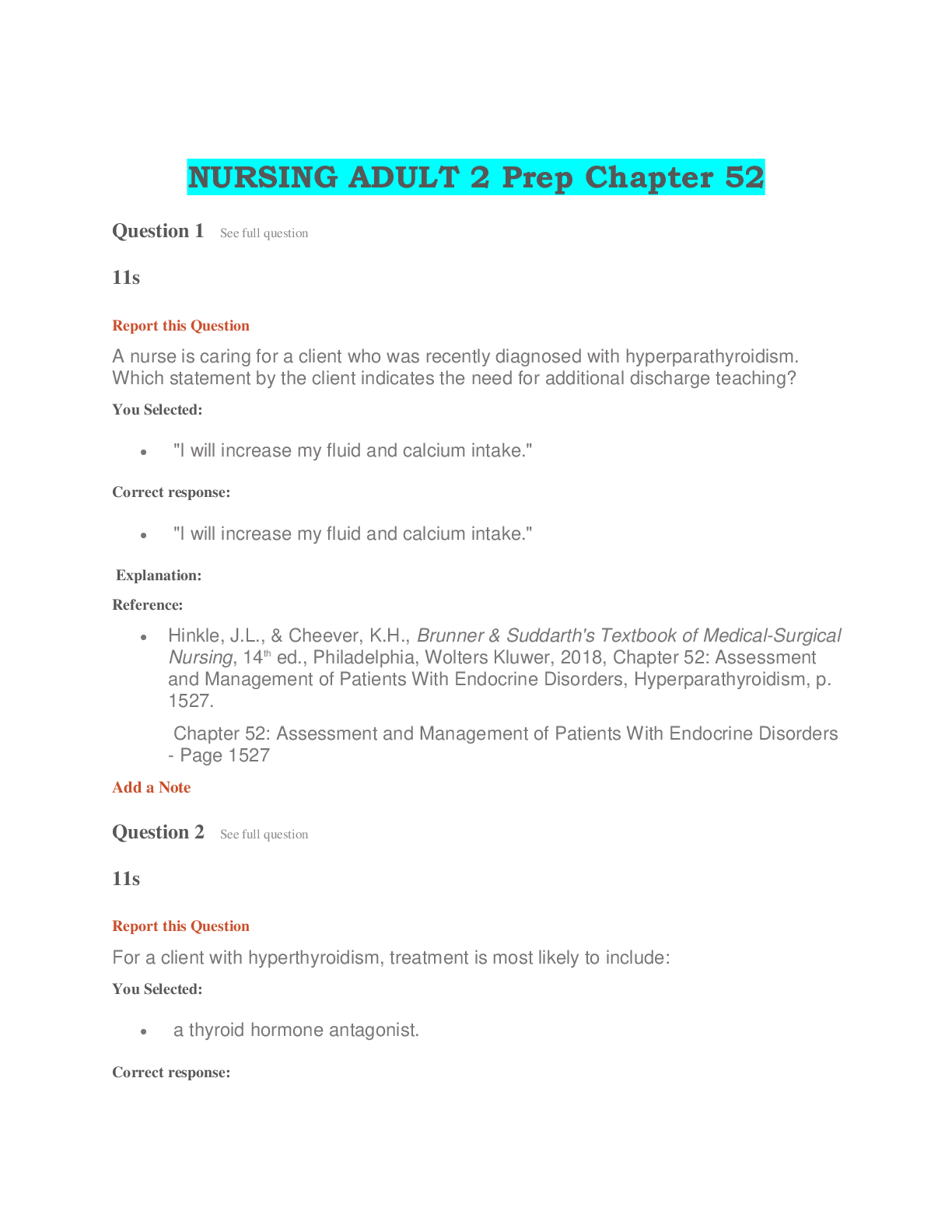
Buy this document to get the full access instantly
Instant Download Access after purchase
Add to cartInstant download
We Accept:

Reviews( 0 )
$8.00
Document information
Connected school, study & course
About the document
Uploaded On
May 16, 2021
Number of pages
36
Written in
Additional information
This document has been written for:
Uploaded
May 16, 2021
Downloads
0
Views
49

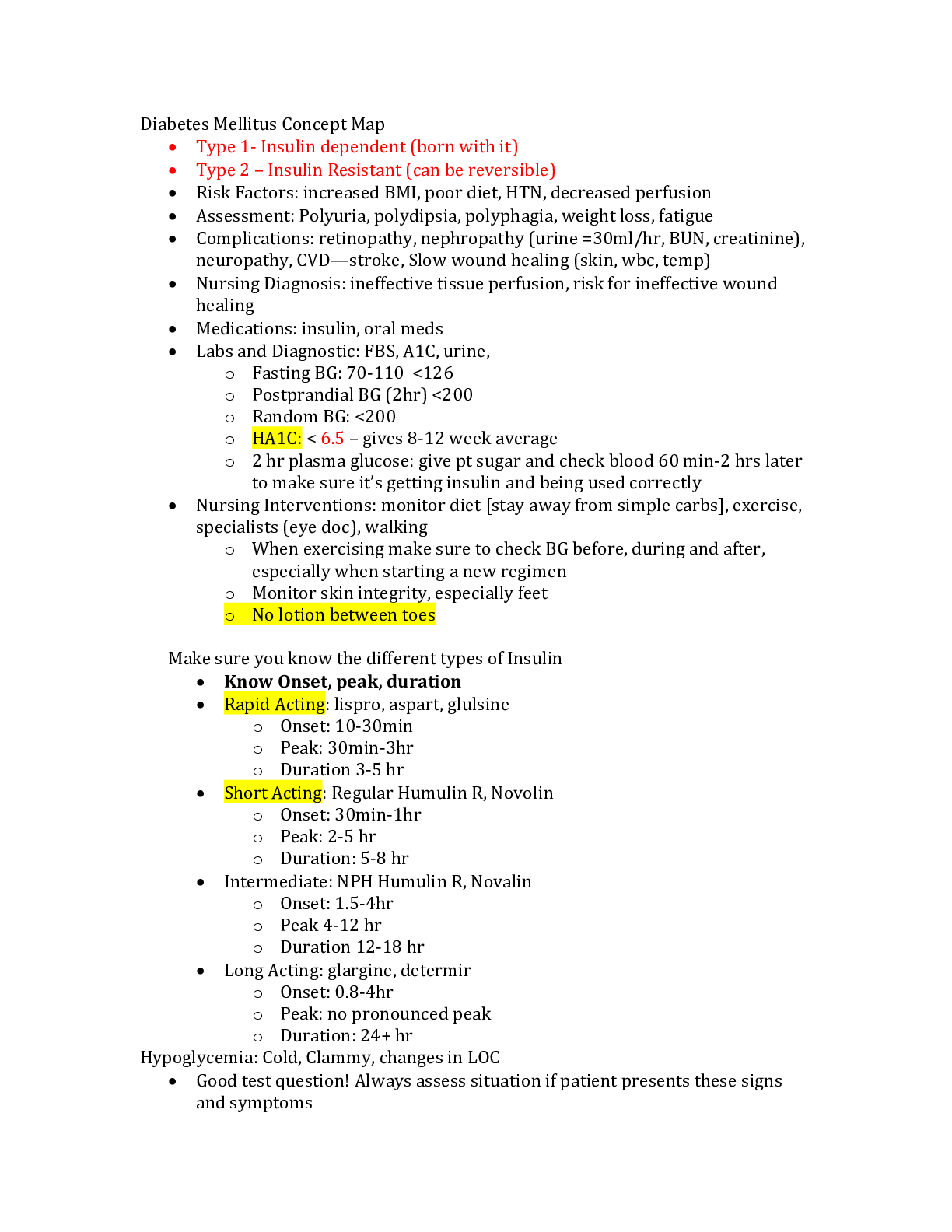
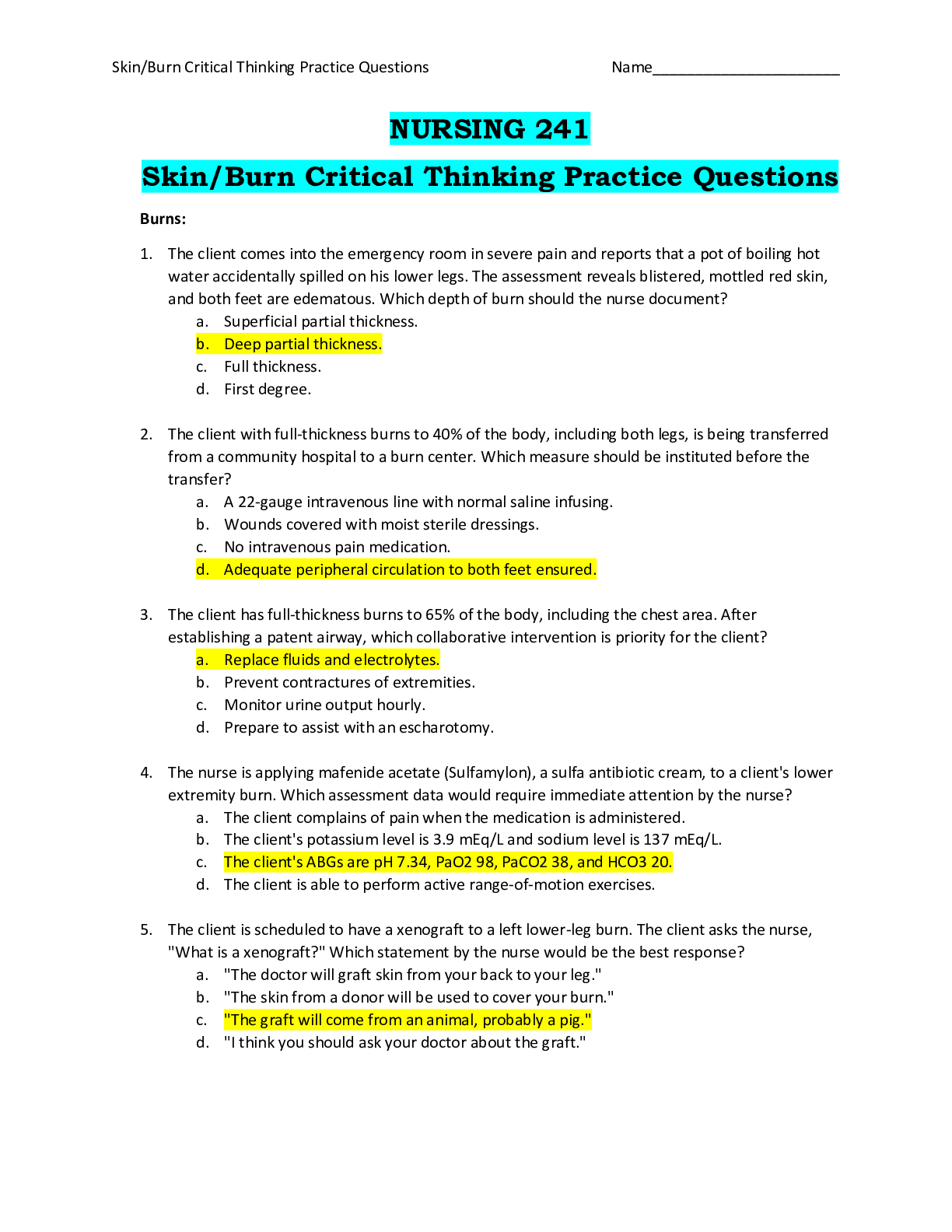
.png)
